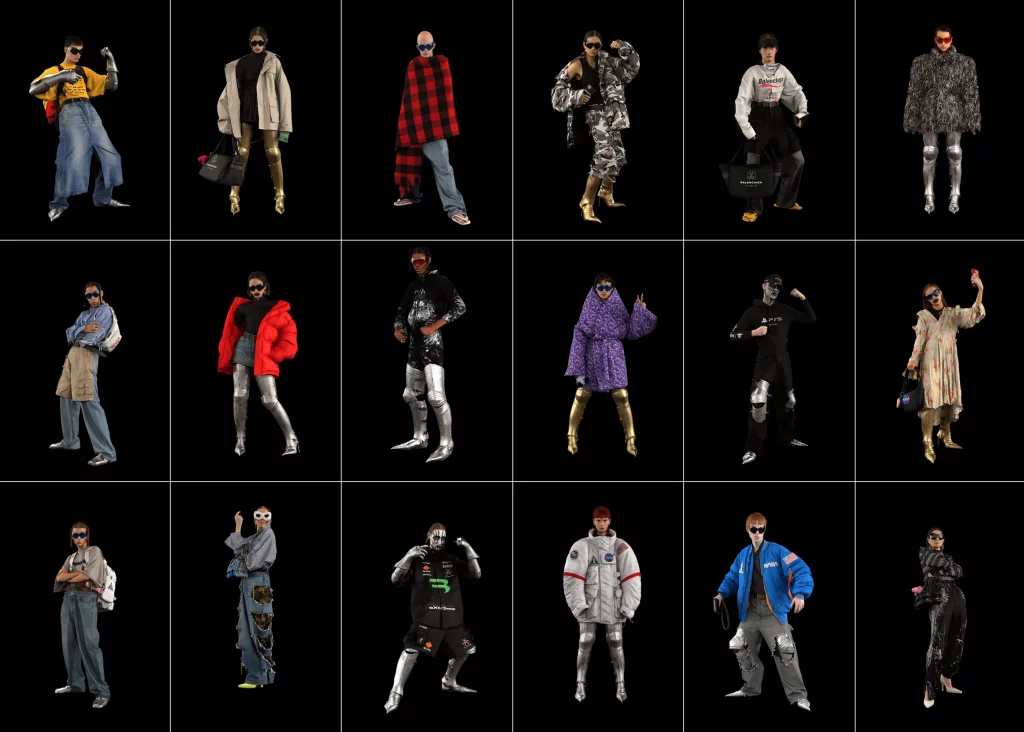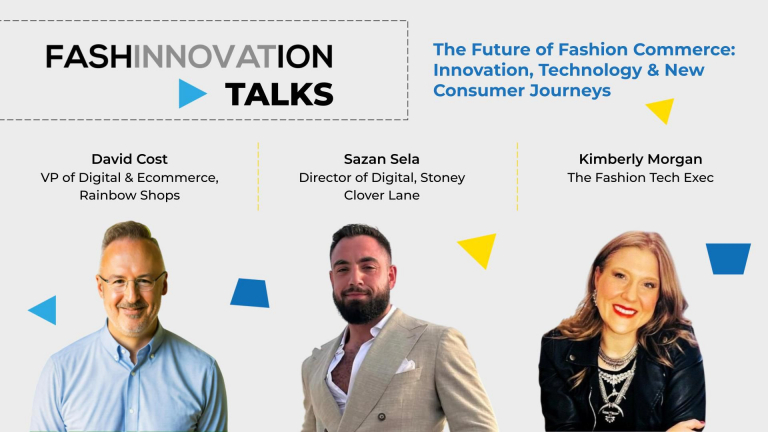The fashion industry is and has been, for a long time, one of the biggest and most important industries in the world. It moved over $1.7 trillion dollars in 2022, and the fashion game maintains its relevance by constantly evolving and mixing new technology with the creativity of designers.
From changes in fabric production to artificial intelligence, innovative fashion is the foundation of this successful market. Aligned with newer market concerns, such as sustainability and speed of production, innovative fashion is shown to be the key for companies that want to make their mark and be relevant in the industry.
When we talk about innovative fashion, people often only think about the new technology we see on runways and in luxury fashion. In 2022, the internet stopped after Coperni spray-painted Bella Hadid’s dress in the middle of the show.
However, real innovation is being implemented in all steps of the supply chain and has changed the way we think, produce, and consume clothes. To illustrate, we have compiled a list of 10 examples of technologies and innovative fashion that are changing the ways of fashion production.
You like this article?
Expand and share your experience with the PDF version!
We promise not to use your contact information to send any kind of spam.
1. Innovative Fashion: The Use of Sheep Supplements to Reduce the Carbon Footprint of Wool Production
In today’s market, a big part of innovative fashion is sustainability, and consumers are increasingly concerned about the impact of their clothes and accessories on the environment.
Therefore, corporations all over the world are investing in science and research studies that can help them make their production less harmful to the planet.
In that regard, the Woolmark Company, an Australian-based company, has heavily invested in identifying how their production was contributing to global warming. Their research showed that the biggest contributor to the problem was, in fact, sheep farms, more specifically, the gas emitted by sheep’s bodily fluids.
To reduce gas emissions, the Woolmark Company introduced new supplements to mitigate methane production in sheep and thus reduce the carbon footprint.
To learn more about the initiative and Woolmark’s perspective on innovative fashion, check out Woolmark’s managing director, John Roberts’ participation in our WorldWide Talks 2023.
2. The Use of Digital Tools to Reduce Production Waste
A big part of the waste generated by fashion happens in the production stages when companies are trying out samples and constructing models, etc. In addition to the environmental impact, the trial and error of designing new pieces can take up a lot of time, extending the path between the creation of the piece and the final customer.
In order to make production more sustainable and fast, corporations have invested a lot of money in new digital innovative fashion tools that can speed up the process and minimize the purchase of materials for prototypes.
These tools can also be used to minimize environmental impact in sales, seeing that it is possible to use artificial intelligence to help customers try on their outfits in virtual reality, reducing the carbon footprint produced by returns in online shopping.
One example of a company that has invested in this type of innovative fashion is Siemens. Siemens is a German enterprise that offers numerous products and recently they have turned their forces into designing software that can increase speed to market in the fashion industry and reduce resources.
Their software allows you to make easy 3D models and experiment with different fabrics and textures, ending the need for physical samples. They also help companies improve their customer experience by utilizing models to create market tools such as better online fitting rooms.
If you are interested in knowing more about how Siemens’ innovative fashion software works, they explained everything during our 2023 World Wide Talks.
3. Use of Big Data to Make Decisions in the Fashion Industry
Choosing the right pieces for a new collection or the price point for that collection can be very challenging, especially for companies that are entering new markets or in times where global consumerism is unstable, for example, during global crises like the COVID-19 pandemic.
Those business decisions have always been difficult in the fashion industry; however, globalization and the expansion of brand coverage due to online selling and social media have put even more pressure into making smart decisions for one’s company.
In order to get around that, multiple enterprises are starting to collect and use big data to justify and orient major business decisions. Things like market research, competition research, and customer expectations are some of the types of data you can assemble to make decisions with a broader perspective.
The problem that companies have faced with big data is being buried in information and end up doing more harm than good. To avoid that, there are already researchers that have focused their products into analyzing and delivering the right data for their clients.
During the World Wide Talks 2023, we received Ketty Pillet from Lectra and Kiran Patel from WGSN to talk about the possibilities of big data in fashion. Watch the streaming to learn how to better use data in innovative fashion.
4. 3D Models and Designer Creativity
Without good design, fashion is nothing. In the new stages of capitalism, customers look for unique and creative pieces, giving a highlight to runway fashion and funky designs.
For designers, creating has always been a challenge, especially visualizing their ideas in real life after the initial sketch. With the evolution of technology and innovative fashion, the industry has been introduced to virtual reality and 3D modeling.
Those tools have changed the way creators think about their clothes, allowing them to add things like fabric, texture, and volume in their original drawings, expanding enormously the barriers of creativity and innovative fashion.
5. Virtual Reality and Artificial Intelligence in Runway Shows
The same technology used for designing is also changing the way brands do catwalks. Each season, brands try their best to innovate and wow spectators during runway shows in order to go viral and make their collections stand out.
Brands from Prada to Balenciaga have tried virtual reality in their shows, embracing innovative fashion. In 2021, Balenciaga even created a video game based on their virtual runway show, where the characters were dressed in clothes from the collection.

Virtual reality allows brands to use numerous resources such as lighting, illusion, and visual effects to improve even more the experience of watching a runway show.
6. Digital ID and Traceability
To think about sustainable and innovative fashion is also to think about work conditions and supplier transparency. Although corporations market their sustainability policies and campaigns, most of them are not transparent about where their suppliers are from and what are the working situations in those factories.
According to the 2022 Fashion Transparency Index, more than half of the 250 largest fashion brands still don’t disclose their first-tier suppliers. With that information, customers can’t be sure they’re really buying from a company that respects workers rights and the environment.
In contrast, there are companies that are really engaging in making it easier for the client to know where the clothes come from, and that is where digital ID comes in. Some enterprises are now creating interactive maps and applications that show the complete trajectory of their fashion production.
A company that has made its name in that field of innovative fashion is the ID Factory. They created a platform where brands can display their production information in an interactive map that makes it easy for clients to know where each step of the production took place.
Initiatives like that make a huge impact in the fashion industry because they encourage companies to be transparent with the need to develop their own form of distributing that information. Discover more about ID Factory in Martina Schiuma’s speech at the 8th edition of the World Wide Talks.
7. AI Face Recognition and the Beauty Industry
The task of picking the right shade for a foundation or the right moisturizer for your specific type of skin can be tricky. A lot of times, people buy new beauty products and end up not liking them because the color isn’t right, or it gives you acne, etc. That results in more and more containers of makeup and skin care products going to landfills while they’re still full.
That’s why researchers have studied a way to combine artificial intelligence and beauty in order to make sure clients are buying the right products. During our 2023 World Wide Talks, we received Adam Gam to talk about the innovative fashion work that is being developed at Perfect Corp.
Perfect Corp has developed an AI shade recognition system that can scan your face and choose between the colors available which is the best for you. They have also created an AI feature that identifies skin characteristics and recommends which types of products match with your skin.
8. Incorporating Electronics into Clothes
Another type of innovative fashion that has made success in the fashion industry is the marriage between clothes and electronics. An Australian company named Wearable X, created by Billy Whitehouse has conquered its place in the spotlight with their creative pieces.
The idea behind the designs is to combine electronics and clothes to give the customer new feelings and experiences while wearing them. For example, they have created a football jersey that gives off vibrations that simulate the players’ feelings during a match. The technology brings the fans closer to their favorite team and expands the game experience.
Understand more about Wearable X and innovative fashion by listening to her speech at our first Miami Talks.
9. Fabric That Grows with You
One of the biggest problems in the fashion industry is the waste generated by it. According to Earth.org, 92 million tonnes of clothes produced every year end up in landfills.
In order to reduce that number, various groups encourage people to stop buying new clothes and wear what they already have. However, for an important part of the population, that is not possible.
Even if wanted, children’s clothes can’t be kept for long because of how fast kids grow. Besides the impact on the planet, it’s also a struggle for parents who have a constant expense that most of the time isn’t cheap.
To resolve that problem, aeronautical engineer Ryan Mario Yasin created a brand called Petit Pli. His idea was to find a way to make clothes that would grow alongside the kids making it last several months and years. Some customers have reported that their pieces lasted for years, adapting to the children’s bodies.
10. Recycling Technology and Sustainable Fashion
Another way to use technology to make fashion more sustainable is by changing the production process of raw materials. New discoveries in factory procedures are making it easier and cheaper to use more sustainable materials, such as recycled polyester.
Using recycled raw materials is a great way to reduce the carbon footprint in fashion production and help minimize the impacts on the planet.
Get a Free Ebook!
Innovative fashion and technology walk together in the path to a healthier and more aware consumerism. Nevertheless, it is important to point out that new technologies don’t necessarily mean more sustainable options. Bear in mind that blockchain technology requires a lot of energy.
Also, strategies such as Big Data use can have negative impacts due to the amount of energy necessary to keep information in the cloud.
*Written by Isadora Pimenta.
If you would like to understand further the relationship between fashion and technology, check out our free ebook called The Marriage of Fashion, Tech & Sustainability.
Like this article? Read this one next: https://fashinnovation.nyc/the-revolution-in-the-fashion-industry/






